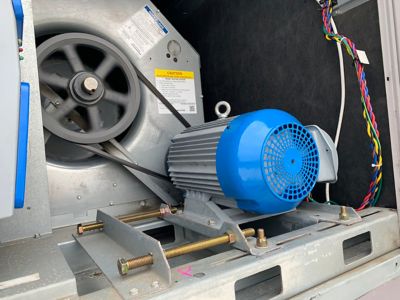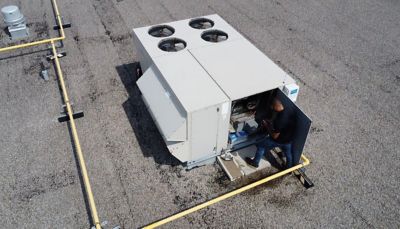-
United States -
United Kingdom -
India -
France -
Deutschland -
Italia -
日本 -
대한민국 -
中国 -
台灣
-
-
产品组合
查看所有产品Ansys致力于通过向学生提供免费的仿真工程软件来助力他们获得成功。
-
ANSYS BLOG
June 14, 2023
Making Every Watt Count: Simulation Helps Turntide Optimize its Motor System 7X Faster on the Cloud
The transition to net-zero is arguably one of the biggest challenges humankind has ever faced. As the planet heats up, key stakeholders including investors, customers, and employees are pressuring companies to reduce their environmental impact, which in turn is prompting those companies to establish environmental, social, and governance (ESG) best practices to help guide them on this journey. These practices echo the ambitions of many large businesses in their commitment to carbon reduction.
According to Turntide Technologies, heating, ventilation, and air conditioning (HVAC) can account for 50% of energy use within buildings. The sustainable technology provider aims to drive down energy costs for these businesses through its motor design, which is deployed as a retrofit to existing HVAC equipment. This seamless plug-and-play solution has helped Turntide customers save an average of 64% on energy costs.
Naturally, demand for sustainable motor technology is growing; however, system optimization is complicated, as it requires analysis across multiple domains in a data-driven, high-compute environment. Turntide introduced Ansys software into its workflow to meet these challenges on the cloud and successfully speed time to market of its sustainable motor designs.

Turntide’s patented V-Series high rotor pole switched-reluctance Smart Motor is setting a new benchmark for sustainable motor solutions.
A Solution to Every Multiphysics Problem
According to Senior Director of Simulation and Analysis at Turntide Biswadip Shome, one critical need Ansys software addresses in the optimization of Turntide’s Smart Motor System™ involves multiphysics.
“For every multiphysics problem, Ansys has a solver, so it’s very multiconnected with the different types of physics we need for successful system optimization. Ansys offers the right technologies to seamlessly tie everything together in an industry standard tool set whether you’re on-premises or on the cloud. So, it becomes very common language to share information within Turntide and with our customers as future needs arise.”
Central to its R&D approach, Turntide uses mixed-cloud technologies and simulation to speed development cycles, shortening design arcs that lead to faster productionization or conversion of a prototype into a product suitable for mass consumption. These simulations are usually run on 32-core workstations using 256 GB of RAM.
Turntide’s Smart Motor System features a high-rotor pole switched reluctance motor (SRM) that operates as a full system plug-in for HVAC systems. In addition to a brand-new motor, customers get a motor controller for speed modulation and remote monitoring on the cloud to better manage their usage — helping business complexes, restaurants, multi-retail sites, and shopping malls save money, energy, and the environment. The motor controller leverages patented algorithms to ensure it is always running at the highest efficiency possible across any load or speed with no harm done to the motor itself.

The powerful Turntide V-Series motor takes center stage in this RTU installation, combining innovation and sustainability.
Risk-Averse Sustainable Motor Designs
During development, Turntide faced specific challenges in the optimization of its sustainable motor system designs. Its SRM technology is linked to highly complex nonlinear physics working within multiple physics domains (e.g., electromagnetics, thermal, structural) and their related nonlinear interactions that had to be solved for motor design optimization. This not only requires iterative solving of individual domains, but also large computations repeated across multiple domains.
The team leveraged Ansys Gateway powered by AWS for their virtual cluster, coupled with Ansys Maxwell electronic solvers to solve these development challenges. Specifically, Maxwell was used to search a large design interface space to establish the geometry and operating points contributing to an optimal motor design early in the motor development process.
This activity helps Turntide mitigate risks in new motor development while also providing the upfront feasibility needed to meet customer requirements and support the viability of its motor production. It also reduces building and testing prototypes without sacrificing team confidence in the final result.

Digital rendering of Turntide's Smart Motor System design.
Computational Power that Grows with You
Over the years, Turntide’s system models have rapidly grown in size and complexity, requiring them to expand a very large and growing computational infrastructure. Ansys Gateway powered by AWS enables motor design optimization over a large design space by leveraging more computing resources to achieve optimization faster.
Thanks to Ansys, Turntide has easy access to all of the simulation software licenses, high-performance computing (HPC) power, and cloud storage needed to perform these large computational tasks in real time. The additional resources enable Turntide’s development team to consider multiple domains that impact its motor designs — including electromagnetics, thermal, and structural characteristics that factor into system performance — all within a disruptive design environment.
All of this computing power has really paid off. Access to HPC gives Turntide the ability to analyze its designs 7X faster on-premise and run 100,000 simulations on Maxwell 2D software. Specifically, where Turntide was previously using 32 cores on-premises to optimize its Smart Motor System, it could now use 128 cores to reduce overall computational times by more than 87%.

Building operators are retrofitting aging HVAC systems with Turntide’s Smart Motor System to improve the energy efficiency of roof top units by upwards of 64%.
Workflows to Optimization with Ansys Gateway Powered by AWS
Recently Turntide supported its customers through the use of Ansys Gateway powered by AWS as part of a workflow to find an optimal SRM design solution. SRMs feature a simplified mechanical magnet-less brushless design that is lightweight yet more durable, reliable, and efficient than brushed DC motor types, which makes them attractive alternatives to more traditional motor applications.
Migrating to Ansys Gateway powered by AWS, the team initially established an automated workflow within optiSlang that extends to Maxwell running on the cloud. In it, Turntide takes the rough-cut requirements (along with some target operating conditions) and imports all of this information into process integration and design optimization software. Objective functions are set to maximize motor performance for efficiency and torque, as well as weight to reduce associated design costs for customers.
“In the past, we were able to run this workflow on local computers,” says Dr. Avisekh Banerjee, Director of Simulation and Analysis, Digital Threads at Turntide Technologies. “Now we have the ability to run it on a massive scale, using as much as 1,520 parameters of search inference space simultaneously across Ansys Gateway powered by AWS. Once you set it up, the automated workflow runs for a few days before arriving at an answer, with minimal post-processing efforts.”
Simulation Leads to Manufacturing Process Improvements
Using simulation, Turntide has also made new discoveries working outside of Ansys Gateway powered by AWS. Recently, the team was tasked to design new housing for a motor that looked quite different from the regular housing they were currently using. At one point, the design went out for prototyping to one of Turntide’s contract manufacturers. When it came back and the team tested it, they found that the results were different than what they had initially anticipated through simulation.
“In the end, the team was able to determine that any design variances were, in fact, coming from the manufacturing process,” says Banerjee. “This was due to the fact that because the design was new, the way it was being manufactured was not conducive to the efficiencies and design parameters required. Simulation gave us a reference point to understand some of the problems we were having in manufacturing the motor that led to significant process improvements.”
Turntide also has big plans for the future. The team predicts opportunities will arise to scale its use of Ansys Gateway powered by AWS for other physics-related challenges. However, as of now, the speed-up, which is primarily due to the availability of large-scale compute hardware and software licenses in the software, is being explored for electric motor design.
To learn more about this story, be sure to check out our case study. If you are interested in trying Ansys Gateway powered by AWS you can also contact us.










